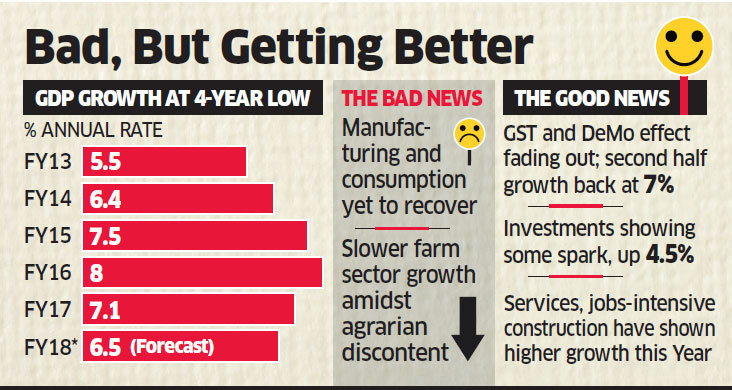Why in news?
- The first Advance Estimate for India’s GDP growth has been released by the Central Statistics Office (CSO).
What are the highlights?
- GDP growth in 2017-18 is estimated to be 6.5% as against 7.1% in 2016-17.
- Growth in GVA (gross value added) is projected to fall to 6.1% in FY18, much lower than the RBI's forecast of 6.7%.
- Manufacturing is projected to have decelerated growth at 4.6% as against 7.9 % in the previous year.
- Agriculture sector is estimated to grow at 2.1%.
- The estimate highlighted that the pace of agricultural expansion is expected to fall by more than half than the previous year.
- This is largely due to decline in kharif output year-on-year.
- Net taxes are projected to grow only 10.9% in the current financial year against 12.8% in the previous year.
- Public expenditure, which was the driver of economic growth in the previous year, is likely to slow.
- Private consumption is projected to record a slow growth in FY18.

What are the positive projections?
- GDP growth is projected to accelerate to 7% in the second half of the current financial year from 6% in the first half.
- Taking this forward, GDP growth is expected to become more robust in 2018-19.
- It is significant in the context of the fact that higher second-half growth has come despite a waning of public sector expenditures.
- Services are projected to go higher.
- This is despite the anticipated fall in growth in government-backed public administration, defence and others.
- This means the government is controlling its expenditure to mange fiscal deficit, which has crossed the Budget Estimates by November itself.
- Evidently, government final consumption expenditure is projected to fall by more than half.
- Investment seems to be reviving a bit with gross fixed capital formation forecast to rise by 4.5% against previous 2.4%.
- Electricity and trade & hotels sectors are expected to grow at a faster pace in FY18 compared with the previous financial year.
What is the significance?
- Growth - This will be the lowest growth rate in the last four years.
- It is largely attributed to the adverse impact of the goods and services tax (GST) and the lingering effects of demonetisation.
- With this, India might possibly lose the tag of being the fastest-growing large economy to China.
- Deficit - The government has increased its spending through supplementary demands for grants.
- It has also indicated that it would borrow Rs 50,000 crore more by 31 March.
- Given this and the lower-than-anticipated nominal GDP growth, there might certainly be a slippage in the fiscal deficit target.
- It could pose a serious challenge to the government's fiscal consolidation roadmap of bringing down the fiscal deficit to 3% of GDP by 2018-19.
- Data - The first advance estimates of GDP are based on data for only seven to eight months.
- Thus it has factored in only limited data for different sectors.
- Given this limitation, a better picture of the health of the economy is expected with the second advance estimates by February.
Source: Business Standard